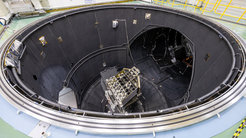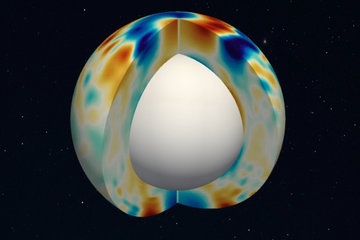PLATO clears decisive hurdle
The European Space Agency (ESA) has given the green light to build the flight models of the spacecraft and science payload for the PLATO mission to search for extrasolar planets. The Critical Milestone Review officially concluded on 11 January 2022. This means that the production of the hardware for the space telescope system can now commence. The German Aerospace Center (Deutsches Zentrum für Luft- und Raumfahrt; DLR) has developed parts of the scientific payload and will be involved in its operations. The Max Planck Institute for Solar System Research (MPS) in Göttingen is leading the development of the PLATO Data Center.
This critical assessment confirms that the complete space segment, which includes both the spacecraft platform and the scientific payload, is at a mature technical level. "The interfaces between the spacecraft and the payload are working and the schedule for the production of the payload, specifically the production of the 26 individual cameras, is firm," explains Heike Rauer from DLR.

This will ensure the spacecraft's operational capability. PLATO (PLAnetary Transits and Oscillation of Stars) will be launched in 2026 and will search for, detect and characterise Earth-like planets in particular, especially those orbiting Sun-like stars. The scientific consortium, which is developing the spacecraft's payload together with ESA, is headed by Heike Rauer, Director of the DLR Institute of Planetary Research in Berlin-Adlershof. Together with the neighbouring DLR Institute for Optical Sensor Systems, the Institute is responsible for the readout electronics of the fast telescopes as well as the payload computers and data processing on board the space telescope system. The PLATO payload consortium is funded through national agencies, including the German Space Agency at DLR, which has received funds from the Federal Ministry for Economic Affairs and Climate Action.
"The 'Critical Milestone' is a decisive step towards the completion of the spacecraft. Never before has a science mission required a comparable number of identical cameras to be built for use in space," emphasises Rauer. "In order to overcome the associated obstacles, this special assessment was necessary, which we have now successfully mastered. We are pleased with the positive outcome and are now looking forward, together with ESA and our partners, to the completion of the mission."
Wanted! Earth-like planets in the 'habitable zone'
The Max Planck Institute for Solar System Research (MPS) in Göttingen is leading the development of the PLATO Data Center, which will process the observational data and measurements on the ground. "An important feature of PLATO is that the mission will also determine the parameters of stars using asteroseismology to infer the radii, masses and ages of their exoplanets with unprecedented accuracy," explains Laurent Gizon, Managing Director of MPS and coordinator of the PLATO Data Center. "Combining the study of exoplanets and stars will be crucial to discovering the first Earth-like planets in the habitable zones of Sun-like stars," says Gizon.
ESA convened the Critical Milestone Review specifically for PLATO to assess the considerable risk associated with the production of the cameras. This exceptionally comprehensive review took place between July and December 2021. More than 100 ESA staff were involved in two teams. One team examined the spacecraft and the other examined the payload. They reported their findings at the end of their review to the panel responsible for the assessment.
Extensive testing across Europe

The final meeting of the review committee took place on 11 January 2022. Almost all aspects were scrutinised – the camera production, the integration of the payload on the spacecraft as well as the functionality. Tests with various qualification models took place in cooperation with the PLATO mission consortium and the industrial companies commissioned to build the spacecraft at various European facilities. Structural, functional and qualification models of the cameras were evaluated. At OHB System AG, the prime contractor for the spacecraft platform, a new test procedure was used to verify the required thermo-elastic properties of the optical bench.
Reaching this 'milestone' marks the beginning of the second phase in the development of the PLATO space telescope system. The spacecraft itself is being built by an industrial consortium that includes the German company OHB System AG, France's Thales Alenia Space, and Switzerland’s RUAG Space. The next 'milestone' for PLATO, which will take place in in 2023, will be the Critical Design Review, during which all details of the entire spacecraft will be verified before the flight model is manufactured and assembled.
In the vicinity of the James Webb Space Telescope
Following the launch, currently scheduled for the end of 2026, PLATO will travel to the second Lagrange point (L2) of the Sun-Earth system, which is 1.5 million kilometres from Earth. This is also where NASA and ESA's James Webb Space Telescope (JWST), which was launched on 25 December 2021, will soon be positioned. PLATO will then direct its 26 cameras towards the outer edge of the Solar System and observe more than 200,000 stars during its four-year nominal operational lifetime. In doing so, the cameras will look for recurring variations in starlight intensity caused by transits, the passage of a planet in front of the stellar disk. Analysis of these transits and intensity changes will allow the properties of newly discovered exoplanets and their host stars to be accurately determined. "PLATO will revolutionise our knowledge of exoplanets from gas giants down to Earth-sized planets," says Rauer, looking forward to the PLATO mission phase.













